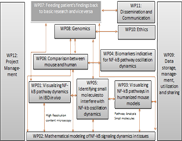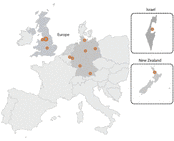WP01 - Visualising NF-kappa-B pathway dynamics in IBD in mice
Objectives
- Generate transgenic mice with fluorescence marked components of the NF-kappa-B pathway (task 1)
- Determine the NF-kappa-B dynamics in vivo in gut and liver tissue in normal mice and mice with inflammatory bowel disease (task 2, 3)
- Introduce the transgenes with fluorescence marked components to mice with genetic susceptibility for IBD or with mutations in the NF-kappa-B Pathway (task 4-7).
The first objective of this work package is to generate mouse mutants that allow the visualisation of the NF-kappa-B pathway dynamics in mice. Data generated in such mice will be used in WP02 to generate mathematical models of NF-kappa-B pathway dynamics in tissue during the development of chronic inflammatory bowel disease. The data will be compared to the data obtained in the humanised mouse model analysed in WP03. The transgenic mouse lines will then be crossed with mouse mutants with increased risk
of IBD and to mutants with defined mutations in the NF-kappa-B Pathway. In the resulting compound mutants, again the dynamics of the NF-kappa-B pathway will be determined and the data will be used as the basis of improved mathematical models in WP02. In case small molecules able to inhibit NF-kappa-B components become available, transgenic mice will be treated, changes in the NF-kappa-B dynamics will be determined and the data used again to improve the mathematical models in WP02.
Workpackage Description
The objective of WP01 is to visualise the NF-kappa-B pathway dynamics in the gut tissue of mice. The workplan is to generate transgenic mice to visualise the oscillating NF-kappa-B behaviour in the mouse. For this, transgenes encoding for component of the NF-kappa-B pathway, tailored for multi photon microscopy, are used to visualise the dynamics of the NF-kappa-B pathway in the gut tissue of mice. We will be able to determine whether NF-kappa-B dynamics within the lesions will be synchronised or not and/or if various cell types display similar or dissimilar oscillation behaviour. In these mice we will determine how the different cell types of the gut, namely gut epithelia cells, mast cells, macrophages/neutrophils, dendritic cells, lymphocytes behave in terms of oscillating NF-kappa-B dynamics. We will study first the steady state and then measure the changes after inducing an inflammatory response, for example by infection of mice with parasites. The deliverables for WP01 are therefore, generation of transgenic mice, determination of NF-kappa-B dynamics for cell types of the normal gut and after inflammation.
Task 1: Generation of transgenic mice with fluorescently marked transgenes of the NF-kappa-B pathway
Transgenes based on bacterial artificial chromosomes with NF-kappa-B genes modified to carry fluorescence proteins will be generated. In these transgenes fluorescence proteins are fused to the components of the NF-kappa-B pathway such that the components are still functional and can be followed by fluorescence microscopy and flow cytometry (01cUNIMAN). The aim of this task is to generate transgenic mice that will express the transgenes properly (08HUJI).
Task 2: Determine the basic NF-kappa-B dynamics in vivo in gut and liver tissue
Mice generated in Task1 will be analysed for the dynamics of the NF-kappa-B pathway. The visualisation of the components in the transgenic animal will allow us to determine the NF-kappa-B pathway dynamics in vivo. In this proposal we will focus on gut and liver tissue. We expect that we can determine the NF-kappa-B dynamics in various cell types in the target tissue. The results will provide us with the basic information of the NF-kappa-B
dynamics in a healthy tissue (02CAU, 03DKFZ).
Task 3: Challenge mice with fluorescence marked components of NF-kappa-B pathway by inducing inflammation
Mice generated in Task 1 will be challenged by various experimental procedures in order to induce inflammation. We will use two well-established challenges, treatment of mice with DSS, infection of mice with parasites resulting in severe gut inflammation. In these challenged mice we will then determine the NF-kappa-B dynamics in the inflamed tissue and compare it to the dynamics in untreated mice and to tissues in the challenged mice without sign of Inflammation.
Task 4: Cross the transgenes onto the IL-10 and the IL-10R1 deficient background
Mice generated in Task 1 will be crossed onto two mouse lines carrying mutations leading to a strongly enhanced risk of developing inflammatory bowel disease, the IL-10 and the IL10receptor deficient mouse lines.
Task 5: Cross the transgenes onto mice with mutations in NF-kappa-B pathway genes
Mouse mutants with gene modifications in the NF-kappa-B pathway available in the lab of partner 05 and 06 will be crossed to the transgenic mouse lines established in Task 1 (06UNILIV).
Task 6: Analyse the development of chronic inflammation in the genetic susceptible mouse mutants
Mice generated in Task 4 and 5 will be followed over time to observe the development of spontaneous IBD in the appropriate condition.
Task 7: Analyse the development of chronic inflammation in the genetic susceptible mouse mutants
Mice generated in Task 4 and 5 will be challenged described in Task 3 and the development of induced IBD in the appropriate condition will be analysed.




